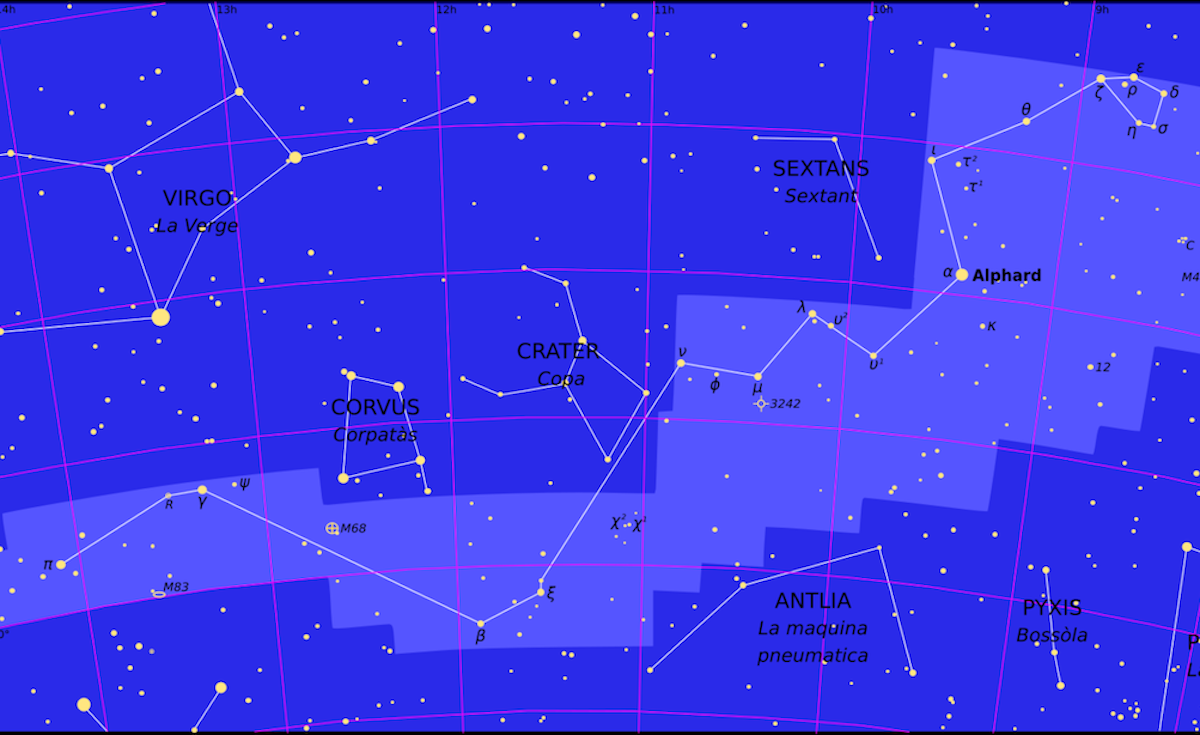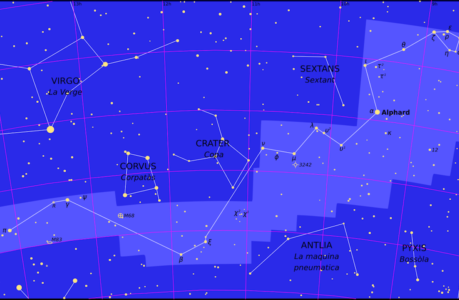As we gaze up at the night sky, we are often mesmerised by the twinkling stars and the vastness of the universe. One of the constellations that captures the imagination of many is Hydra, the water serpent. It is the largest of all the constellations and has a rich history and mythology associated with it. In this article, we will explore the mysteries of Hydra and how to view it from Ireland.
Hydra is located in the southern hemisphere and is visible from Ireland during certain times of the year. It is a long and winding constellation that spans over 100 degrees of the night sky. It is often difficult to view in its entirety, as it extends from the horizon up to the zenith, and is best viewed in a dark location away from city lights.
The history of Hydra dates back to ancient times when it was known as the Lernean Hydra. In Greek mythology, the Hydra was a monstrous serpent with nine heads that lived in the swamps near the city of Lerna. It was said to be invincible because whenever one of its heads was cut off, two more would grow in its place. The Hydra was eventually defeated by the hero Hercules, who used a sword to cut off all of its heads and burned the stumps to prevent them from growing back.
In astronomy, Hydra is a fascinating constellation because it contains a wide variety of celestial objects. It is home to many galaxies, including the Hydra Cluster, which is one of the closest galaxy clusters to our own Milky Way. There are also many star clusters, including the globular cluster Messier 68, and the open clusters NGC 3114 and NGC 3242. Additionally, Hydra contains a number of double stars, such as the binary star HD 82443, which is visible through a small telescope.
To view Hydra from Ireland, you will need to know the best time of year to look for it. The constellation is visible from late winter to early summer, with the best viewing occurring in April and May. You will need to find a dark location away from city lights and allow your eyes to adjust to the darkness for at least 20 minutes. Hydra is best viewed with binoculars or a small telescope, which will allow you to see the different stars and celestial objects within the constellation.
In conclusion, Hydra is a fascinating constellation that has captured the imagination of people for centuries. From the mythology of ancient Greece to the scientific discoveries of modern astronomy, Hydra has a rich history and significance. If you are interested in viewing this magnificent star cluster from Ireland, be sure to find a dark location and bring binoculars or a small telescope. Who knows what secrets and wonders you might uncover as you explore the mysteries of Hydra.
How can I see the constellation of Hydra from Ireland?
To see the constellation of Hydra from Ireland, you will need to wait for a clear night with minimal light pollution. Hydra is a southern hemisphere constellation, so it is best viewed from the southern hemisphere, but it is still visible from Ireland during certain times of the year.
The best time of year to view Hydra from Ireland is from late winter to early summer, with the best viewing occurring in April and May. During this time, Hydra is visible in the south-southeastern part of the sky, near the constellation of Centaurus.
To locate Hydra, you can start by looking for the bright star, Achernar, which is the ninth brightest star in the sky and is located in the constellation of Eridanus. From there, you can follow a line extending from Achernar towards the southeast until you come across a faint, serpentine shape. This is the constellation of Hydra.
Hydra is a large and winding constellation that spans over 100 degrees of the night sky, so it may be difficult to see all of it in one view. It is best viewed in a dark location away from city lights and with binoculars or a small telescope. Allow your eyes to adjust to the darkness for at least 20 minutes before attempting to view the constellation.
In summary, to see the constellation of Hydra from Ireland, wait for a clear night with minimal light pollution, look for the bright star Achernar, and follow a line extending towards the southeast until you come across a faint, serpentine shape. Use binoculars or a small telescope and find a dark location away from city lights for the best viewing experience.
The mythology of the constellation of Hydra
The constellation of Hydra has a rich mythology that dates back to ancient Greece. In Greek mythology, Hydra was known as the Lernaean Hydra, a monstrous serpent with multiple heads that lived in the swamps near the city of Lerna.
According to legend, the Hydra was the offspring of Typhon and Echidna, two powerful monsters in Greek mythology. The Hydra was said to be invincible because whenever one of its heads was cut off, two more would grow in its place. It was also said to have poisonous breath and blood that was deadly to humans.
The Hydra was eventually defeated by the hero Hercules as part of his Twelve Labors. Hercules was tasked with killing the Hydra, which had been terrorising the people of Lerna. Hercules used a sword to cut off one of the Hydra’s heads, but quickly realised that two more had grown in its place.
To defeat the Hydra, Hercules enlisted the help of his nephew Iolaus. As Hercules cut off each head, Iolaus cauterised the stump with a torch, preventing any new heads from growing. Finally, Hercules cut off the last head and buried it under a rock, ending the threat of the Lernaean Hydra.
The Hydra’s defeat was seen as a triumph of good over evil, and Hercules was celebrated as a hero for his bravery and strength. The Hydra became a symbol of the dangers that lurked in the natural world and the need for human beings to remain vigilant against them.
In addition to its role in mythology, Hydra has also played a significant role in scientific discoveries. The constellation is home to many galaxies and celestial objects, making it a popular target for astronomers and researchers. The Hydra Cluster, one of the closest galaxy clusters to our own Milky Way, is located in the constellation of Hydra, as are several star clusters and double stars.
In summary, the mythology of the constellation of Hydra is a fascinating tale of a monstrous serpent that was eventually defeated by the hero Hercules. This story has been passed down through the ages and has become an enduring symbol of the triumph of good over evil. The constellation of Hydra also plays a significant role in scientific discoveries, adding to its rich history and significance.
The Stars in the constellation of Hydra
The constellation of Hydra is the largest of all the 88 modern constellations and is located in the southern sky. It is named after the Lernaean Hydra, a mythical serpent with multiple heads from Greek mythology. Hydra is a challenging constellation to see in its entirety, as it stretches across a large area of the sky, but it is home to many interesting stars and celestial objects.
Here are some of the most notable stars in the constellation of Hydra:
- Alphard (Alpha Hydrae): Alphard is the brightest star in the constellation of Hydra and the 41st brightest star in the night sky. Its name comes from the Arabic word for “the solitary one” because it appears alone in a relatively empty region of the sky.
- HD 82443: This is a binary star system in Hydra that consists of two yellow-white main-sequence stars. The two stars are close enough that they orbit around a common centre of mass and can be observed with a small telescope.
- U Hydrae: This is a variable star that belongs to the class of Mira variables, which are red giants that exhibit pulsations in their brightness over a period of several hundred days. U Hydrae has a period of 315 days and varies in brightness from magnitude 6.5 to magnitude 12.5.
- Epsilon Hydrae: This is a double star system in Hydra that consists of two stars that are separated by about 2 arcseconds. The two stars are both yellow-white main-sequence stars, with magnitudes of 3.4 and 4.5.
- Zeta Hydrae: This is a triple star system in Hydra that consists of two yellow-white main-sequence stars and a red dwarf star. The two main stars are separated by about 2 arcseconds, while the red dwarf is much farther away. Zeta Hydrae is an interesting system to observe with a telescope.
In addition to these stars, Hydra is also home to many galaxies, star clusters, and other celestial objects. The Hydra Cluster, one of the closest galaxy clusters to our own Milky Way, is located in the constellation of Hydra, as are several star clusters, such as NGC 3114 and NGC 3242, and the globular cluster Messier 68.
Overall, the constellation of Hydra is a fascinating area of the night sky to explore, with many interesting stars and celestial objects to observe. Whether you are an amateur astronomer or just someone who appreciates the beauty of the night sky, Hydra is definitely worth checking out.

